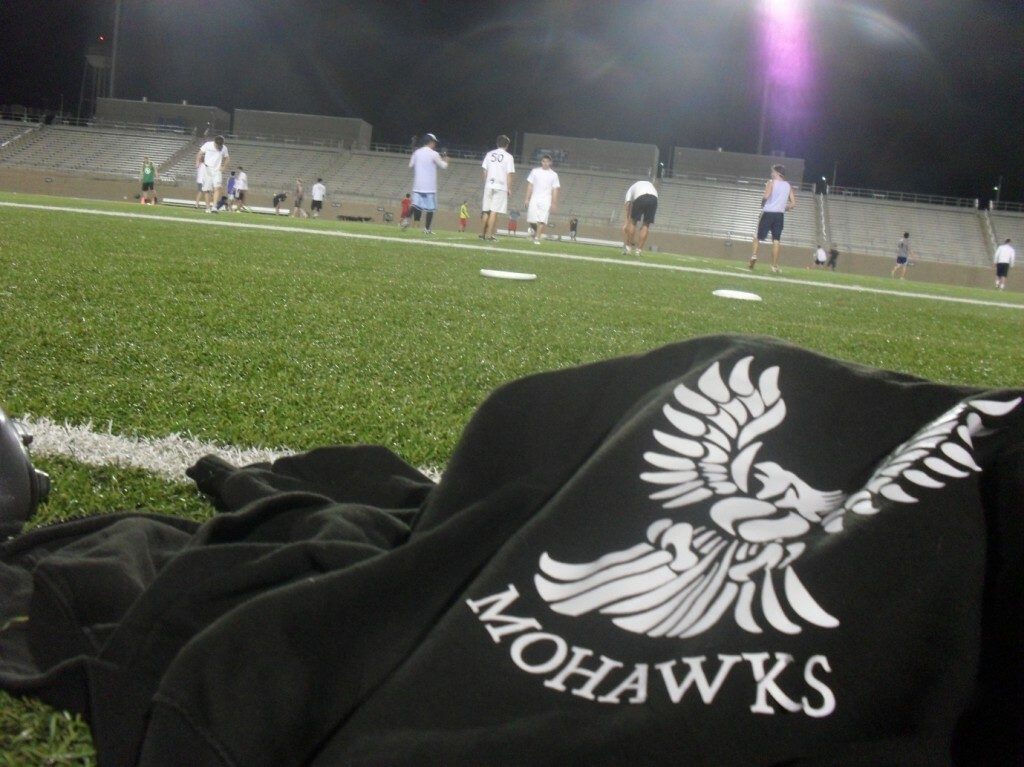- 29th November 20129th March 2022
- by megan
Handler Weave: See it in action!
So, turns out that nitty gritty details take a lot of words. The details of what throw to block when, the specific patterns they will be running are less important than discipline and pressure. If you remember anything, remember those.
Because the detail post is so detailed, I thought it’d be better to put up the footage and some comments on that first.
The main things to watch for are what the Skunks D players get right and wrong. Mostly, their pressure is excellent – they’re close the whole time. Where they often go wrong is a lack of discipline – forgetting the force and overcommitting, either as the force or as upfield D players. Also, watch how relentlessly Ro Sham run up the line – expect this from teams playing handler weave.
Final starts @10.49. [times may not match up exactly depending on how well it uploaded – sorry if they’re a little out…]
People to watch out for from Ro Sham Bo: #5 Linda (dark skirt), #8 Georgie (dark shorts), #1 Jools (turquoise skirt). You’ll see these three running the handler weave most of the time.
People to watch out for from Skunks: Em Rees #3 (white skirt), mostly marking Jools. Lou Kittow, #18, playing a lot of handler defence too.
11.20 is your first look at the 2-1-2 handler set up. Jools in the bright blue skirt is the ‘1’ – she’s right in the middle of the pitch like god, with lots of space. Brigid (pink skirt) and Georgie (shorts) are the first ‘2’ – and together they form a triangle.
Here you’ll see them go for the ‘first look’ of the iso throw to Jools (Skunks are forcing to the right of the screen – Georgie is attempting to get the disc to Jools’ left). You can see why few teams still use this start to the play – iso or god throws are high risk throws. If I had to guess at anyone using this, I’d guess Ro Sham (who Squaws 1 may face in pre-quarters if we both hold seed) might open with this look. Fling (who are in our pool) are likely to go straight for the running version.
11.30 – This is our next look at the Ro Sham offence and they’re running. What Skunks do well here is both apply pressure and be very disciplined (note: they are now forcing to the left of the screen). Em (white skirt, on force) doesn’t let the disc swing off the sideline (where Georgie is running), and Lou refuses to get beaten under by Linda and is rewarded with a “run through” D (although she’s never really behind Linda). Most importantly, everyone is remembering the force.
[Note on the Skunks offence here – they are CLINICAL. No jabby jabby straight at the endzone – the disc comes off the line, and move again before the window is wide enough for the score to be thrown.]
11.50. New Ro Sham offence. The running version. Georgie (one of the 2) goes up the line, looking for the disc, then is forced back to the break side. What Skunks do well here is that they’re close (pressure!) and the force isn’t easily breakable. What the marker on Georgie does wrong is over commit to that break side run – and gets beaten back to the open side as a result. Don’t get broken; stay open side. This is one of the trickiest bits of playing D against this offence, because every cut is so predictable that you want to D the disc if it gets thrown there. This is where discipline comes in – remember that force and force yourself to trust it.
Again, after the disc moves to Georgie, watch Jools (in her tiny blue skirt) burn it up the line, just about get marked out by Em and then go breakside. The throw to her isn’t perfect – it’s late, and it gives Em a bid. This is probably due to the force hassling Georgie. Again, this is about discipline: give up open side point blocks in this offence and block the hell out of any breaks they try to throw.
After this pass to Jools, you’ll see Skunks lose discipline: Em (after the break going) over commits to the open side on force and is lucky not to get broken. Lou (marking Georgie) overcommits to the break side as a result of this throw looking easier than it should, and gets beaten back openside by Georgie. Again, after this, Lou bites a little too much open side, and lets the break back out to Jools.
However. Although they’ve lost discipline, Em and Lou are doing a pretty good job of being really bloody close every time their person gets the disc – the last three catches have been pretty close. Pressure time. As well as this pressure making the offence a little jittery and forcing a few poor decisions or throws, there’s another element. Handler weave puts a lot of the workload onto relatively few players – offence are going to be tired after a few turnovers, and they’re playing a tough offence for when they’re tired. If you need a boost mid-point, remember that for a second on D.
12.49. Ro Sham are full on selling out into this offence – you can see not the usual 2, but 3 of their players legging it to the endzone to leave Jools and Linda the entire pitch to work up.
Skunks let a break out immediately, Linda continues the break to Jools, forces a great grab. You’ll see Jools make a lot more of these, and while it says a lot about her as a player, it says more about the gradual consistent pressure of Skunks’ D – as the points go on, Ro Sham will force the disc into smaller windows, or throw too far out in front to get the disc away from the pressure of the Skunks D.
[13.20 – Nice toe in by Jools.]
13.37 – the camera fades in as Jools fakes the swing pass to Linda, which Em has done a good job of taking away at the force, and the upfield D player has done a good job of being reasonably tight on. Whoever is marking Brigid (pink skirt) upfield has lost a little focus, perhaps given themselves not enough of a buffer and let her run at the open side to get the disc (sidenote: I think that’s Anna who now plays for Brighton Women). She also lets that swing off the line go back to Jools, who you’ll notice Em has marked out on the up line cut. You’ll then see Em help out her other upfield D player from getting beaten open side by getting a point block. All coolness of point blocks aside: no open side point blocks. Hold your force.
14.28 – the break sideline is probably the hardest place to play the Ro Sham offence from – your upline cut is now breakside, it’s hard to hit the iso throw and the swing cut is also open side. Icky. Linda’s force makes the error of giving a stuff about the open side and getting broken in a pretty devastating manner. It’s a great throw but that should never be an option. It’s worth also noting that the disc is in the air for a reasonably long time – if the endzone D players are certain they can get a D on it, they should go for it – and until the disc is that close to the endzone, they should be heads up to see if they can help out on discs like this.
[14.55. Whoaaaah. Big hammer.]
14.59. More handler weave – here you can see that they’re back to having 3 handlers, with Linda (#5) in the ‘iso’ or 1 spot. They’re going for the running offence, and Georgie’s mark overbites on that break cut again, and gets beaten open – discipline fail. Having said that they’re playing with 3 handlers, Linda shifts out the way pretty sharpish and is far more inactive than you’d usually expect in this offence.
15.16 – another overbite on force (up the line), after getting beaten to the open side. This lets out the killer break to Linda – it’s overthrown but this is the throw they wait pretty much the whole offence for. Don’t OVERBITE on force!!!
15.35 – Lou gets beaten by a circle cut from Georgie. Em gets beaten up the line by Jools – note that Em gets beaten here because she doesn’t move AS SOON AS JOOLS HAS THROWN. You know where they’re going – up the line. Beat them there.
16.24 – The Skunks D player beats Georgie open side under, but turns her back on Georgie in doing so. This is a BAD THING. In this offence, you’ve gotta be real focused on your man (the disc is useful to watch to a lesser extent), and you need to have your hips and footwork helping you out with this.
17.18 – Skunks get beaten up the line, after a swing to a poached off player. This is naughty. Don’t poach off, and don’t get beaten up the line. Em has a little moment where she sort of forgets the force and lets Jools sneak up the line away from her. This is a pretty important part of defence against the handler weave – no dozing off. You must remain focused, more so than pretty much any other time on defence.
18.23 – Ro Sham are a little bit back into the game – primarily because the Skunks D players are looking tired – where previously they’ve been close if beaten they’re now just beaten. They’ve had a lapse in pressure, and the other side effect of getting tired is often a lapse in discipline – you forget the force, you overbite on cuts when you should be shadowing. Ro Sham are still turning over though, because this is a high risk offence, and it is tiring for them as well.
The next point though (8-7) and Skunks are back on it – they’re real close, and there’s a lot more pressure at the point of the force, which leads to mounting pressure – Ro Sham don’t turn over on a swing, but they’re worn down by that pressure, and the lack of free passes.
Skunks get a little looser again on the D – and Ro sham work it up the pitch up the line and into the endzone. 8-8.
[Now watch the exciting conclusion!!!]
 Blog Posts
Blog Posts


